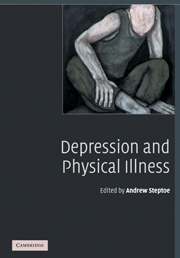Book contents
- Frontmatter
- Contents
- List of contributors
- Preface
- Part 1 Introduction to depression and its determinants
- Part 2 Depression and specific health problems
- Part 3 Biological and behavioural processes
- 12 Inflammation, sickness behaviour and depression
- 13 The hypothalamic–pituitary–adrenal axis: cortisol, DHEA and mental and behavioural function
- 14 Depression and immunity: biological and behavioural mechanisms
- 15 Smoking and depression
- 16 Depression and physical activity
- 17 Depression and adherence to medical advice
- Part 4 Conclusions
- Index
- References
15 - Smoking and depression
from Part 3 - Biological and behavioural processes
Published online by Cambridge University Press: 17 September 2009
- Frontmatter
- Contents
- List of contributors
- Preface
- Part 1 Introduction to depression and its determinants
- Part 2 Depression and specific health problems
- Part 3 Biological and behavioural processes
- 12 Inflammation, sickness behaviour and depression
- 13 The hypothalamic–pituitary–adrenal axis: cortisol, DHEA and mental and behavioural function
- 14 Depression and immunity: biological and behavioural mechanisms
- 15 Smoking and depression
- 16 Depression and physical activity
- 17 Depression and adherence to medical advice
- Part 4 Conclusions
- Index
- References
Summary
Introduction
Cigarette smoking remains the most preventable cause of illness and death in society today. Upwards of 440 000 smokers die in the USA each year [1, 2], and worldwide over 1 200 000 deaths a year are attributable to smoking-related causes [3]. Despite these staggering statistics, smokers and non-smokers alike often do not appreciate fully the health risks of tobacco use, particularly cigarette smoking. The latest epidemiological studies indicate that death rates for smokers are two to three times higher than for non-smokers at all ages. This means that half of all smokers will eventually die as a result of their smoking. If current smoking trends persist, then about 500 million people currently alive – nearly 9% of the world's population – will die as a result of tobacco use [3].
Moreover, tobacco is arguably the most addictive substance known to humankind. Whereas approximately 32% of people who initiate cigarette smoking become nicotine-dependent, only 23%, 17% and 15% of individuals who experiment with heroin, cocaine and alcohol, respectively, become dependent on these drugs [4]. Interestingly, unlike with harder drugs, the subjective effects of smoking are subtle. Rarely does a smoker describe that smoking provides them with anything approaching the euphoria or high often attributed to other drugs. And yet, as Shiffman [5] observes, ‘the addictive potential of nicotine is all the more impressive for its ability to engender such compulsive use without impressive subjective effects’ (p. 15).
The pathways to becoming a smoker are no doubt complex [6, 7].
Keywords
- Type
- Chapter
- Information
- Depression and Physical Illness , pp. 321 - 347Publisher: Cambridge University PressPrint publication year: 2006
References
- 8
- Cited by

